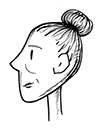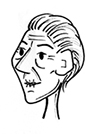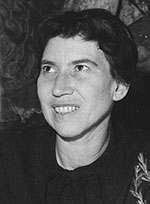Natalia Ginzburg
Description is an essential part of a narrative text, since it not only introduces the setting to the reader but also introduces characters and events. You will soon be reading a short descriptive extract from a literary text by Natalia Ginzburg.
Natalia Ginzburg
Natalia Ginzburg was born Natalia Levi in Palermo in 1916. Her father’s family was Jewish and her mother’s was Catholic, but she was brought up an atheist. In 1919 the family moved to Turin, where the Levi household became a meeting place for many intellectuals who opposed Mussolini. Natalia studied at the University of Turin. In 1938 she married the political activist Leone Ginzburg. The Ginzburgs spent some years in Abruzzo, where Leone was sent into exile for political reasons, though they both went to Rome secretly to edit an anti-Fascist newspaper. Ginzburg’s first novel was published under a pseudonym because of the race laws. Leone Ginzburg was arrested and killed by the Fascists in 1944 and in the 1950s Natalia remarried and returned to Rome, where she began her most prolific period of writing.
Among her best-known works are Lessico famigliare (1963), an account of her childhood through her family’s sayings and phrases, and the play Ti ho sposato per allegria (1965). Ginzburg wrote about her personal experiences in a fictionalised form and many of her works are based on memories of her childhood and youth in Turin. She died on 7 October 1991.
First of all, you can do some vocabulary work to prepare you for the reading activity coming up next.
Attività 16
Read the following expressions (which occur in the next activity) and match them to the corresponding drawings.
Leggete le seguenti parole e abbinatele alle immagini corrispondenti.
Using the following two lists, match each numbered item with the correct letter.
Ha un impermeabile finta tigre.
Con le occhiaie e le rughe.
La Zezé ha i piedi ossuti.
Con i capelli puntati in cima alla testa.
Le sacche della spesa.
a.

b.

c.

d.

e.

- 1 = b
- 2 = e
- 3 = c
- 4 = a
- 5 = d

